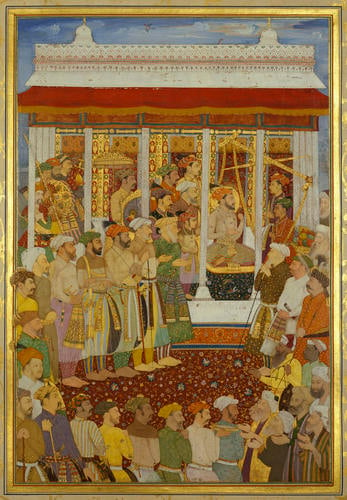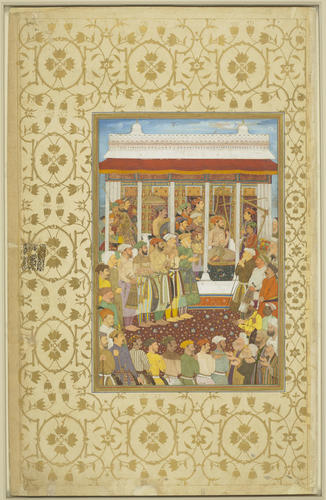-
1 of 253523 objects
The Weighing of Shah-Jahan on his 42nd lunar birthday (23 October 1632) c. 1640
Painting in opaque watercolour including metallic paints. | 31.9 x 21.4 cm (image) | RCIN 1005025.n

Bhola
Master: Padshahnamah پادشاهنامه (The Book of Emperors) Item: The Weighing of Shah-Jahan on his 42nd lunar birthday (23 October 1632) c. 1640

Bhola
Master: Padshahnamah پادشاهنامه (The Book of Emperors) Item: The Weighing of Shah-Jahan on his 42nd lunar birthday (23 October 1632) c. 1640

Bhola
Master: Padshahnamah پادشاهنامه (The Book of Emperors) Item: The Weighing of Shah-Jahan on his 42nd lunar birthday (23 October 1632) c. 1640



-
Padshahnamah fol. 71r
(plate 13)
The weighing of Shah-Jahan at the Agra Fort on his 42nd lunar birthday.
The twice-yearly weighing of the Emperor on both his solar and his lunar birthdays were among the greatest annual festivals of the Mughal court. This painting records the weighing ceremony on 23 October 1632 when 'the Emperor, surrounded by a divine aura, was weighed against gold and silver and the other usual things, and the skirt of the world was held out in expectation. On this auspicious day Muhammad-Ali Beg, the ambassador of Persia, was awarded a gold-embroidered robe of honour and given leave to depart.' Muhammad-Ali Beg is depicted at the right-hand edge of the scene wearing orange.
The ceremony took place in the Diwan-i Khass (the Hall of Private Audience) in the imperial fort at Agra. The pavilion is draped with fine textiles and those attending the ceremony stand on a large floral carpet under an awning. The five figures closest to Shah-Jahan are his four sons and his father-in-law, Asaf Khan, whose nephew Jafar Khan stands at his right shoulder. On the right, mullahs hold their arms out ready to receive an amount of gold and silver equal to the Emperor’s weight which they are then to distribute among the poor and destitute.
The artist Bhola signed his name under the figure of the Emperor and technical analysis has revealed his unusual working methods. The painting does not appear to have a ground layer and the underdrawings are vague. Several changes were made to the composition as it was being painted and areas of thicker and thinner paint show the artist’s reworking, and he used the same cartoon in the shape of an arm for all the figures at the bottom centre of the scene. The painting was previously in a different volume, cut down for inclusion in this book, and there are traces of rulings from the earlier volume around the edge.
Similar weighing scenes exist of Emperor Akbar (Chester Beatty Library, In. 2.146) and Shah-Jahan when a prince (British Museum, 1948,1009,0.69). An 18th century European print engraved by James Roberts also depicts ‘The ceremony of weighing the Great Mogul on his birthday, in the Royal Pavilion.’
Bibliography:
Milo Beach and Ebba Koch, King of the world : the Padshahnama, an imperial Mughal manuscript from the Royal Library, Windsor Castle, 1996
Saqib Baburi, Beyond the Akbarnamah: Padshahnamahs and Official Regnal Chronography for Shah-Jahan Padshah (r. 1037/1628-1068/1658), 2010.Provenance
Illustration from a Padshahnamah manuscript formerly in the Mughal imperial library and acquired by Asaf al-Dawlah, Nawab of Awadh, c.1780-90; presented by Saadat Ali Khan, Nawab of Awadh, to George III via Lord Teignmouth in June 1799.
-
Creator(s)
(illustrator)Acquirer(s)
-
Medium and techniques
Painting in opaque watercolour including metallic paints.
Measurements
31.9 x 21.4 cm (image)
58.4 x 36.9 cm (page dimensions)
Category